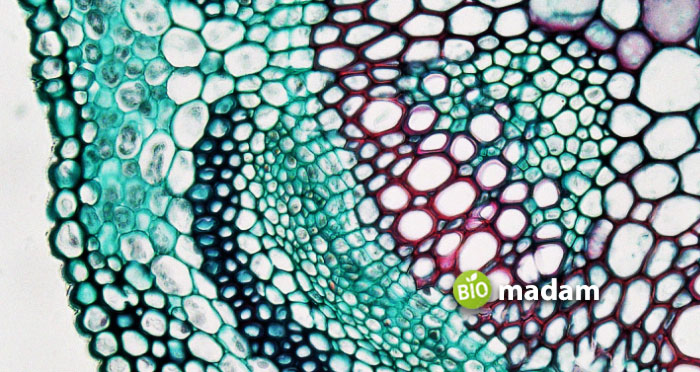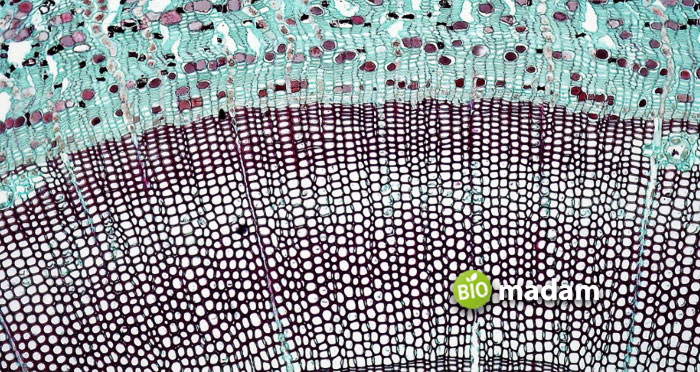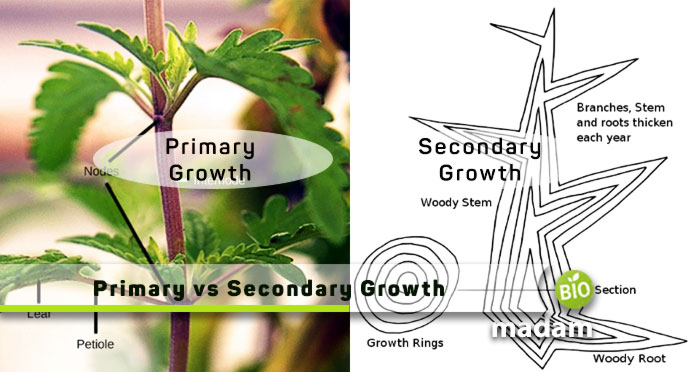Recently updated on October 4th, 2023 at 10:05 am
All the tall, gigantic plants you see around are a result of appropriate plant growth with essential nutrients. They are essential for life as they are the producers in the food chain and even in the food web. Plants are autotrophs opposed to heterotroph and consumers around us. Thus, their proper growth is vital to life.
However, plants do not grow the same way throughout their life. Instead, the growth patterns vary, which we will discuss in detail further. The development comprises primary and secondary growth. The former enables the plant to grow taller, whereas the latter adds to the width. Besides this fundamental difference between primary and secondary growth, their location, occurrence and growth processes also differ. Both involve specific cells and tissues, leading to an increase in height and size. Read till the end to know everything about primary and secondary growth.
Comparison Table
| Characteristic | Primary Growth | Secondary Growth |
| Definition | Increase in length | Increase in diameter |
| Tissues | Primary meristem | Lateral meristem |
| Involved Meristematic Tissues | Apical meristem, intrafascicular cambium & intercalary meristem | Vascular cambium and cork cambium |
| Occurrence | Shoot apex | Lateral meristem cells |
| Type of Growth | Longitudinal | Radial |
| Growth Period | Before completion of differentiation | After maturity |
| Product | Primary xylem & phloem | Secondary xylem & phloem |
What is Primary Growth?
Primary growth refers to the increase in the length of the roots and shoots. In easy words, primary plant growth is associated with lengthwise growth.
Primary plant growth in botany and horticulture can be defined as the increase in plant size because of cell division at the tip of roots and stems. It causes them to elongate and produce primary tissue. It occurs by mitosis and cytokinesis in primary meristems such as intercalary meristems, apical meristems and intrafascicular cambium.

The dome-shaped shoot apex with leaf primordia has axillary nodes, internodes and buds. It also has three regions; the region of cell division on the very top. The cell enlargement area is next to the cell division region, followed by cell differentiation. The growth process occurs step by step when the cell first divides, enlarges and then specializes in a particular function.
Besides the intercalary meristems, intravascular cambium and apical meristems, three types of meristematic tissues are present at the stem apex. They include procambium, protoderm and ground meristem. The procambium produces primary vascular tissues and looks like continuous longitudinal strands. However, their appearance resembles a broken ring when viewed in cross-section. Protophloem forms on the outside, whereas protoxylem grows on the inside. The protoxylem cavity is quite smaller compared to the protophloem. The vascular and non-vascular tissues contribute to the overall shape and structure of the plant.
Elongation in the protoxylem occurs through the spiral and annular thickening of lignin. However, the function of protoxylem and protophloem is short-lived. They are replaced by metaphloem and metaxylem. Plants require adequate water and sunlight for proper primary growth.
Characteristics of Primary Growth
- Primary growth is the increase in size lengthwise.
- It enables the growth and development of shoots and roots.
- It occurs at the tip where primary meristem tissues are present.
- Primary growth is not restricted to the shoot or roots and occurs in various plant parts.
- It results from cell division at the apex followed by cell elongation and differentiation.
- Primary growth gives primary xylem and phloem, also known as protoxylem and protophloem.
What is Secondary Growth?
Contrary to primary growth, secondary growth causes an increase in the width and girth of the plant. It results from cell division in the lateral meristems after primary division. Cell division in these regions causes the roots and stems to thicken and provide better support. Secondary growth is a characteristic specific to gymnosperms, woody magnolids and eudicots. Monocots, angiosperms, and similar plants do not show prominent secondary growth.

The initiation of secondary growth gives rise to secondary xylem and secondary phloem through the vascular cambium. Unlike collenchyma and sclerenchyma, parenchyma cells in the vascular bundles become meristematic, giving rise to the interfascicular cambium. The interfascicular and intrafascicular cambium fuse to form the cambial ring. Secondary growth in vascular plants typically results from lateral meristems, vascular cambium and cork cambium. The increase in the tree’s diameter depends on the production of new cells by the lateral meristems. The continual production of new cells from the meristem thickens woody plants by producing wood and a thickened trunk. You may find various gymnosperms with secondary growth in your community and ecosystem.
Characteristics of Secondary Growth
- Secondary growth occurs after primary growth.
- It is the increase in width and thickness of the plant.
- Secondary growth is only present in dicots and is absent in monocot and herbaceous plants.
- It is a characteristic of mature plants only.
- This kind of development results from the lateral meristems instead of the primary meristems.
- The increase in plant width is a combined action of cork and vascular cambium.
- The primary xylem and phloem develop into secondary xylem and phloem.
- Lenticels, bark and periderm are produced as a result of secondary growth.
Similarities Between Primary and Secondary Growth
- Primary and secondary growth leads to an increase in the size of the plant.
- They result from meristematic tissues (primary and lateral).
- They both occur in woody plants.
Differences Between Primary and Secondary Growth
Definition
Primary Growth
Primary growth refers to the lengthwise increase in the size of roots or shoots.
Secondary Growth
On the contrary, secondary growth is the increase in the width and diameter of the plant.
Growth Tissues
Primary Growth
Primary growth results from the primary meristematic cells.
Secondary Growth
Whereas secondary growth is seen as a result of cell division in the lateral meristem.
Involved Meristematic Tissues
Primary Growth
The apical meristem, intrafascicular cambium and intercalary meristem contribute to primary growth.
Secondary Growth
Alternatively, vascular and cork cambium are involved in secondary growth in plants.
Occurrence
Primary Growth
Primary growth occurs at the shoot apex through cell division, followed by cell elongation and differentiation.
Secondary Growth
Conversely, it grows from the lateral or secondary meristem.
Type of Growth
Primary Growth
The plant experiences growth along the longitudinal axis during primary development.
Secondary Growth
Oppositely, secondary growth leads to radial growth.
Growth Period
Primary Growth
It halts when the tissue differentiation is completed.
Secondary Growth
In contrast, secondary growth occurs in only mature plants after primary growth.
Product
Primary Growth
Primary growth gives rise to the primary xylem and phloem, also called protoxylem and protophloem.
Secondary Growth
Secondary growth results in secondary xylem and phloem.
The Bottom Line
Growth is inevitable for any organism or microorganism to survive and live a healthy life. Primary and secondary growth is different in presentation but essential to plant development. The former results in longitudinal growth, whereas the latter increases the diameter, contributing to radial growth. However, secondary growth is specific to woody, dicot plants and absent in monocots and herbaceous plants. It is one of the critical functions of vascular tissues in plants.
FAQs
What is the difference between primary and secondary growth?
Primary growth helps in cell division and elongation lengthwise, while secondary growth thickens the tree trunk following primary growth.
What is the difference between primary and secondary tissues?
Primary growth results from the primary meristem, whereas secondary tissues are regulated by lateral meristem.
What is the difference between primary and secondary roots?
Primary roots consisting of basal roots, tap roots and lateral roots are present in young plants. Secondary roots develop as side branches of the primary roots.
Why is secondary growth important?
Secondary growth is essential to woody plants as they grow taller than herbaceous plants and need rigid support. The thickening of the trunk provides the required support to the plants.

Hello, I would like to introduce myself to you! I am Chelsea Rogers, an experienced blog writer for science articles, holding an MPhil degree. My enthusiasm to grab the best knowledge, let it relate to botany, zoology, or any other science branch. Read my articles & let me wait for your words s in the comment section.

